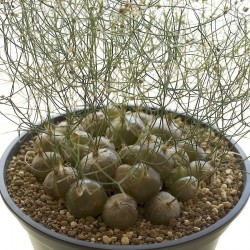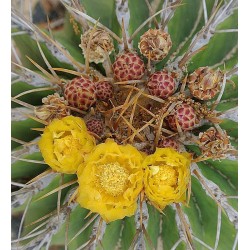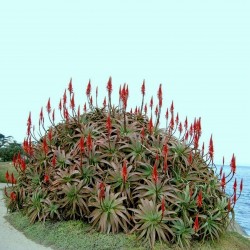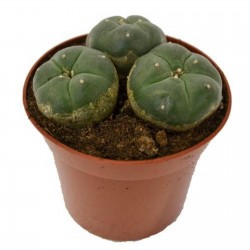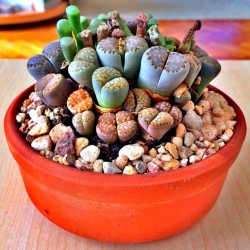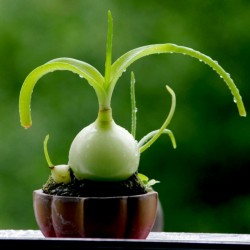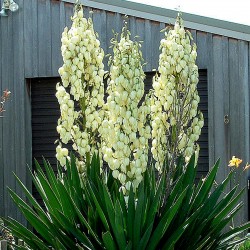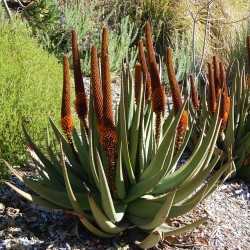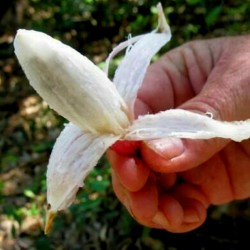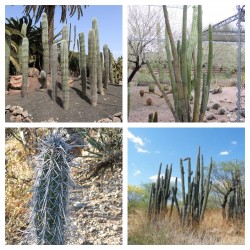Seeds Gallery Com,
5/
5
<h2 class=""><strong>Nasiona Jukka karolińska (Yucca filamentosa)</strong></h2>
<h2><span style="color: #ff0000;"><strong>Cena za opakowanie 5 nasion.</strong></span></h2>
<b style="color: #202122; font-size: 14px;">Jukka karolińska</b><sup id="cite_ref-2" class="reference" style="color: #202122;"></sup><span style="color: #202122; font-size: 14px;">, juka karolińska, krępla karolińska, krępla włóknista, juka włóknista, szpilecznica włóknista</span><sup id="cite_ref-buchwald_3-0" class="reference" style="color: #202122;"></sup><span style="color: #202122; font-size: 14px;"><span> </span>(</span><i style="color: #202122; font-size: 14px;">Yucca filamentosa</i><span style="color: #202122; font-size: 14px;">) –<span> </span></span><a href="https://pl.wikipedia.org/wiki/Gatunek_(biologia)" title="Gatunek (biologia)" style="color: #0645ad; font-size: 14px;">gatunek</a><span style="color: #202122; font-size: 14px;"><span> </span>zimozielonej rośliny z rodziny<span> </span></span><a href="https://pl.wikipedia.org/wiki/Szparagowate" title="" style="color: #0645ad; font-size: 14px;">szparagowatych</a><span style="color: #202122; font-size: 14px;">. Pochodzi z południowo-wschodnich stanów<span> </span></span><a href="https://pl.wikipedia.org/wiki/Stany_Zjednoczone" title="Stany Zjednoczone" style="color: #0645ad; font-size: 14px;">USA</a><span style="color: #202122; font-size: 14px;">, rozprzestrzeniła się także w innych rejonach USA</span><sup id="cite_ref-4" class="reference" style="color: #202122;"></sup><span style="color: #202122; font-size: 14px;">. Jest uprawiana w wielu krajach świata jako roślina ozdobna.</span><br />
<h2 style="color: #000000; font-size: 1.5em;"><span class="mw-headline" id="Zasięg_występowania">Zasięg występowania</span></h2>
<p style="color: #202122; font-size: 14px;">Naturalny zasięg występowania juki karolińskiej to środkowe, wschodnie i południowe regiony<span> </span><a href="https://pl.wikipedia.org/wiki/Stany_Zjednoczone" title="Stany Zjednoczone" style="color: #0645ad;">Stanów Zjednoczonych</a><span> </span>(<a href="https://pl.wikipedia.org/wiki/Michigan" title="Michigan" style="color: #0645ad;">Michigan</a><span> </span>i<span> </span><a href="https://pl.wikipedia.org/wiki/Nowy_Jork_(stan)" title="Nowy Jork (stan)" style="color: #0645ad;">Nowy Jork</a><span> </span>po<span> </span><a href="https://pl.wikipedia.org/wiki/Teksas" title="Teksas" style="color: #0645ad;">Teksas</a><span> </span>i<span> </span><a href="https://pl.wikipedia.org/wiki/Floryda" title="Floryda" style="color: #0645ad;">Florydę</a>). Zasiedla tam świetliste lasy, nieużytki i przydroża. W warunkach klimatycznych<span> </span><a href="https://pl.wikipedia.org/wiki/Europa" title="Europa" style="color: #0645ad;">Europy</a><span> </span>jest hodowana jako roślina ozdobna w ogrodach<sup id="cite_ref-grabowska_5-0" class="reference"><a href="https://pl.wikipedia.org/wiki/Jukka_karoli%C5%84ska#cite_note-grabowska-5" style="color: #0645ad;">[5]</a></sup>. Jest jednym z najbardziej mrozoodpornych i najmniej wymagających gatunków juk dzięki czemu zdecydowanie nadaje się do hodowli w Polsce na powietrzu<sup id="cite_ref-6" class="reference"><a href="https://pl.wikipedia.org/wiki/Jukka_karoli%C5%84ska#cite_note-6" style="color: #0645ad;">[6]</a></sup>.</p>
<h2 style="color: #000000; font-size: 1.5em;"><span class="mw-headline" id="Morfologia">Morfologia</span></h2>
<dl style="color: #202122; font-size: 14px;">
<dt><a href="https://pl.wikipedia.org/wiki/%C5%81odyga" title="Łodyga" style="color: #0645ad;">Łodyga</a><span> </span>i<span> </span><a href="https://pl.wikipedia.org/wiki/Li%C5%9B%C4%87" title="Liść" style="color: #0645ad;">liście</a></dt>
<dd>Łodygi brak lub występuje krótka (do 30 cm wysokości), drewniejąca i ukryta wśród liści. Liście są nieco mięsiste, elastyczne, odwrotnie lancetowate, wyraźnie zwężone na szczycie i ostro zakończone, na brzegach nitkowato rozwłóknione, koloru zielonego lub niebieskozielonego od woskowego nalotu. Osiągają długość ok. 50-75 cm i szerokość 2,5-5 cm<sup id="cite_ref-grabowska_5-1" class="reference"><a href="https://pl.wikipedia.org/wiki/Jukka_karoli%C5%84ska#cite_note-grabowska-5" style="color: #0645ad;">[5]</a></sup>.</dd>
<dt><a href="https://pl.wikipedia.org/wiki/Kwiat" title="Kwiat" style="color: #0645ad;">Kwiaty</a></dt>
<dd>Zebrane w<span> </span><a href="https://pl.wikipedia.org/wiki/Kwiatostan" title="Kwiatostan" style="color: #0645ad;">kwiatostan</a><span> </span>wyrastający latem ze środka dorosłej rozety, silny, drewniejący pęd o wysokości 100-180 cm, z czego co najmniej połowa przypada na kwiatostan. Kwiaty są liczne, zwieszone, dzwonkowate, koloru białego lub kremowobiałego, niekiedy zielono nabiegłe.<span> </span><a href="https://pl.wikipedia.org/wiki/Okwiat" title="Okwiat" style="color: #0645ad;">Okwiat</a><span> </span>ma formę kulistą. Listki jajowate, na szczycie lekko zaostrzone, o długości 40-60 mm i szerokości 20-30 mm<sup id="cite_ref-grabowska_5-2" class="reference"><a href="https://pl.wikipedia.org/wiki/Jukka_karoli%C5%84ska#cite_note-grabowska-5" style="color: #0645ad;">[5]</a></sup>.</dd>
<dt><a href="https://pl.wikipedia.org/wiki/Owoc" title="Owoc" style="color: #0645ad;">Owoce</a></dt>
<dd><a href="https://pl.wikipedia.org/wiki/Torebka_(botanika)" title="Torebka (botanika)" style="color: #0645ad;">Torebki</a><span> </span>o długości 40-60 mm, wyprostowane, suche i pękające<sup id="cite_ref-grabowska_5-3" class="reference"><a href="https://pl.wikipedia.org/wiki/Jukka_karoli%C5%84ska#cite_note-grabowska-5" style="color: #0645ad;">[5]</a></sup>.</dd>
</dl>
<h2 style="color: #000000; font-size: 1.5em;"><span class="mw-headline" id="Biologia">Biologia</span></h2>
<p style="color: #202122; font-size: 14px;">Kwitnie na przełomie lipca i sierpnia<sup id="cite_ref-buchwald_3-1" class="reference"><a href="https://pl.wikipedia.org/wiki/Jukka_karoli%C5%84ska#cite_note-buchwald-3" style="color: #0645ad;">[3]</a></sup>. W warunkach naturalnych roślinę cechuje specyficzny sposób zapylania, z udziałem molika<span> </span><i><a href="https://pl.wikipedia.org/wiki/Tegeticula_yuccasella" title="Tegeticula yuccasella" style="color: #0645ad;">Tegeticula yuccasella</a></i>. Samica tego owada zeskrobuje pyłek z pręcików jednej rośliny i przenosi go na drugą, gdzie wwierca<span> </span><a href="https://pl.wikipedia.org/wiki/Pok%C5%82ade%C5%82ko" title="Pokładełko" style="color: #0645ad;">pokładełko</a><span> </span>w<span> </span><a href="https://pl.wikipedia.org/wiki/Znami%C4%99_(botanika)" title="Znamię (botanika)" style="color: #0645ad;">znamię</a><span> </span>słupka, składa w każdym jedno jajo, a następnie zatyka otwór pyłkiem. Gąsienice żywią się<span> </span><a href="https://pl.wikipedia.org/wiki/Zal%C4%85%C5%BCek" title="Zalążek" style="color: #0645ad;">zalążkami</a>, jednak część z nich pozostaje i rozwija się w nasiona<sup id="cite_ref-7" class="reference"><a href="https://pl.wikipedia.org/wiki/Jukka_karoli%C5%84ska#cite_note-7" style="color: #0645ad;">[7]</a></sup>.</p>
<h2 style="color: #000000; font-size: 1.5em;"><span class="mw-headline" id="Zastosowanie">Zastosowanie</span></h2>
<p style="color: #202122; font-size: 14px;">Cała roślina wraz z korzeniami wykorzystywana jest w lecznictwie. Pozyskuje się z niej frakcję saponinową, zawierającą ok. 1,2%<span> </span><a href="https://pl.wikipedia.org/wiki/Saponiny" title="Saponiny" style="color: #0645ad;">saponin</a>, z których najważniejsze to<span> </span><a href="https://pl.wikipedia.org/w/index.php?title=Sarsapogenina&action=edit&redlink=1" class="new" title="Sarsapogenina (strona nie istnieje)" style="color: #ba0000;">sarsapogenina</a><span> </span>i<span> </span><a href="https://pl.wikipedia.org/w/index.php?title=Tigogenina&action=edit&redlink=1" class="new" title="Tigogenina (strona nie istnieje)" style="color: #ba0000;">tigogenina</a>. Po izolacji składniki te są produktem do syntezy<span> </span><a href="https://pl.wikipedia.org/wiki/Kortykosteroidy" title="Kortykosteroidy" style="color: #0645ad;">kortykosteroidów</a><span> </span>i hormonów płciowych<sup id="cite_ref-buchwald_3-2" class="reference"><a href="https://pl.wikipedia.org/wiki/Jukka_karoli%C5%84ska#cite_note-buchwald-3" style="color: #0645ad;">[3]</a></sup>. Od niedawna wyciągi z jukki używane są także do leczenia zapaleń<span> </span><a href="https://pl.wikipedia.org/wiki/Staw_(anatomia)" title="Staw (anatomia)" style="color: #0645ad;">stawów</a>, przebiegających z ich zesztywnieniem i obrzękami<sup id="cite_ref-8" class="reference"><a href="https://pl.wikipedia.org/wiki/Jukka_karoli%C5%84ska#cite_note-8" style="color: #0645ad;">[8]</a></sup>. W przemyśle wykorzystuje się włókno pozyskane z liści, przerabiane następnie na grube tkaniny i wyroby powroźnicze.<br /><br /><span jsaction="mouseup:BR6jm" jsname="jqKxS" lang="pl"><strong><span jsaction="agoMJf:PFBcW;usxOmf:aWLT7;jhKsnd:P7O7bd,F8DmGf;Q4AGo:Gm7gYd,qAKMYb;uFUCPb:pvnm0e,pfE8Hb,PFBcW;f56efd:dJXsye;EnoYf:KNzws,ZJsZZ,JgVSJc;zdMJQc:cCQNKb,ZJsZZ,zchEXc;Ytrrj:JJDvdc;tNR8yc:GeFvjb;oFN6Ye:hij5Wb" jscontroller="Zl5N8" jsmodel="SsMkhd" jsname="txFAF" data-language-for-alternatives="pl" data-language-to-translate-into="en" data-phrase-index="12" jsdata="uqLsIf;_;$288"><span jsaction="click:qtZ4nf,GFf3ac,tMZCfe; contextmenu:Nqw7Te,QP7LD; mouseout:Nqw7Te; mouseover:qtZ4nf,c2aHje" jsname="W297wb">Używa</span></span></strong><span jsaction="agoMJf:PFBcW;usxOmf:aWLT7;jhKsnd:P7O7bd,F8DmGf;Q4AGo:Gm7gYd,qAKMYb;uFUCPb:pvnm0e,pfE8Hb,PFBcW;f56efd:dJXsye;EnoYf:KNzws,ZJsZZ,JgVSJc;zdMJQc:cCQNKb,ZJsZZ,zchEXc;Ytrrj:JJDvdc;tNR8yc:GeFvjb;oFN6Ye:hij5Wb" jscontroller="Zl5N8" jsmodel="SsMkhd" jsname="txFAF" data-language-for-alternatives="pl" data-language-to-translate-into="en" data-phrase-index="13" jsdata="uqLsIf;_;$289"><span jsaction="click:qtZ4nf,GFf3ac,tMZCfe; contextmenu:Nqw7Te,QP7LD; mouseout:Nqw7Te; mouseover:qtZ4nf,c2aHje" jsname="W297wb"><strong> </strong><br /></span></span><span jsaction="agoMJf:PFBcW;usxOmf:aWLT7;jhKsnd:P7O7bd,F8DmGf;Q4AGo:Gm7gYd,qAKMYb;uFUCPb:pvnm0e,pfE8Hb,PFBcW;f56efd:dJXsye;EnoYf:KNzws,ZJsZZ,JgVSJc;zdMJQc:cCQNKb,ZJsZZ,zchEXc;Ytrrj:JJDvdc;tNR8yc:GeFvjb;oFN6Ye:hij5Wb" jscontroller="Zl5N8" jsmodel="SsMkhd" jsname="txFAF" data-language-for-alternatives="pl" data-language-to-translate-into="en" data-phrase-index="14" jsdata="uqLsIf;_;$290"><span jsaction="click:qtZ4nf,GFf3ac,tMZCfe; contextmenu:Nqw7Te,QP7LD; mouseout:Nqw7Te; mouseover:qtZ4nf,c2aHje" jsname="W297wb">Po usunięciu nasion owoce można gotować i jeść.</span></span> <span jsaction="agoMJf:PFBcW;usxOmf:aWLT7;jhKsnd:P7O7bd,F8DmGf;Q4AGo:Gm7gYd,qAKMYb;uFUCPb:pvnm0e,pfE8Hb,PFBcW;f56efd:dJXsye;EnoYf:KNzws,ZJsZZ,JgVSJc;zdMJQc:cCQNKb,ZJsZZ,zchEXc;Ytrrj:JJDvdc;tNR8yc:GeFvjb;oFN6Ye:hij5Wb" jscontroller="Zl5N8" jsmodel="SsMkhd" jsname="txFAF" data-language-for-alternatives="pl" data-language-to-translate-into="en" data-phrase-index="15" jsdata="uqLsIf;_;$291"><span jsaction="click:qtZ4nf,GFf3ac,tMZCfe; contextmenu:Nqw7Te,QP7LD; mouseout:Nqw7Te; mouseover:qtZ4nf,c2aHje" jsname="W297wb">Duże płatki kwiatów można również spożywać w sałatkach.</span></span><span jsaction="agoMJf:PFBcW;usxOmf:aWLT7;jhKsnd:P7O7bd,F8DmGf;Q4AGo:Gm7gYd,qAKMYb;uFUCPb:pvnm0e,pfE8Hb,PFBcW;f56efd:dJXsye;EnoYf:KNzws,ZJsZZ,JgVSJc;zdMJQc:cCQNKb,ZJsZZ,zchEXc;Ytrrj:JJDvdc;tNR8yc:GeFvjb;oFN6Ye:hij5Wb" jscontroller="Zl5N8" jsmodel="SsMkhd" jsname="txFAF" data-language-for-alternatives="pl" data-language-to-translate-into="en" data-phrase-index="16" jsdata="uqLsIf;_;$292"><span jsaction="click:qtZ4nf,GFf3ac,tMZCfe; contextmenu:Nqw7Te,QP7LD; mouseout:Nqw7Te; mouseover:qtZ4nf,c2aHje" jsname="W297wb"> </span></span><span jsaction="agoMJf:PFBcW;usxOmf:aWLT7;jhKsnd:P7O7bd,F8DmGf;Q4AGo:Gm7gYd,qAKMYb;uFUCPb:pvnm0e,pfE8Hb,PFBcW;f56efd:dJXsye;EnoYf:KNzws,ZJsZZ,JgVSJc;zdMJQc:cCQNKb,ZJsZZ,zchEXc;Ytrrj:JJDvdc;tNR8yc:GeFvjb;oFN6Ye:hij5Wb" jscontroller="Zl5N8" jsmodel="SsMkhd" jsname="txFAF" data-language-for-alternatives="pl" data-language-to-translate-into="en" data-phrase-index="17" jsdata="uqLsIf;_;$293"><span jsaction="click:qtZ4nf,GFf3ac,tMZCfe; contextmenu:Nqw7Te,QP7LD; mouseout:Nqw7Te; mouseover:qtZ4nf,c2aHje" jsname="W297wb">Liście, łodygi i korzenie tej rośliny mogą być używane do ogłuszania ryb.</span></span> <span jsaction="agoMJf:PFBcW;usxOmf:aWLT7;jhKsnd:P7O7bd,F8DmGf;Q4AGo:Gm7gYd,qAKMYb;uFUCPb:pvnm0e,pfE8Hb,PFBcW;f56efd:dJXsye;EnoYf:KNzws,ZJsZZ,JgVSJc;zdMJQc:cCQNKb,ZJsZZ,zchEXc;Ytrrj:JJDvdc;tNR8yc:GeFvjb;oFN6Ye:hij5Wb" jscontroller="Zl5N8" jsmodel="SsMkhd" jsname="txFAF" data-language-for-alternatives="pl" data-language-to-translate-into="en" data-phrase-index="18" jsdata="uqLsIf;_;$294"><span jsaction="click:qtZ4nf,GFf3ac,tMZCfe; contextmenu:Nqw7Te,QP7LD; mouseout:Nqw7Te; mouseover:qtZ4nf,c2aHje" jsname="W297wb">Cherokee użył go do tego celu.</span></span></span> <br /><sup id="cite_ref-9" class="reference"></sup></p>
CT 8 (5 S)




